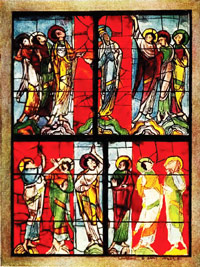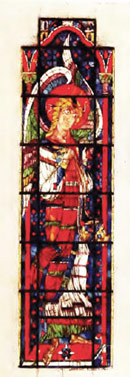Stained Glass Painting in the Middle Ages
Medieval stained glass painting representing figures is mentioned as early as the 10th century. Between 968 and 989, Adalberon, Archbishop of Reims, introduced legendary scenes into the windows of the Church of St. Remy at Reims.
The stained glass paintings of the Middle Ages borrowed the characteristics of both the mosaic and enamel works, the former suggesting how to put together small pieces of colored glass, while the latter influenced the handling of colors. These two elements, together with the windows draperies, embroidered or woven, had a great influence in the introduction of stained glass.
Theophilus, a German monk writing in the 12th century, mentioned the French as being the cleverest masters of stained glass art. Indeed, their painting works were of superior artistic quality.

Ascension Window
Le Mans Cathedral, 11th Century
During the Middle Ages, painting in general followed but slowly the advances made in architecture. The stained glass windows of Abbot Suger at Saint Denis, transitioning from Romanesque, seldom exhibit the pointed forms in the architectural details.
A further stage of Medieval stained glass painting is exemplified by the four windows of the Cathedral of Angers (1125-1149), containing representations of the legends of the saints , executed in medallions upon a blue ground. These were the earliest in a series of similar paintings on glass, like those of the western front of the Cathedral of Chartres, and those of the choir of St. Denis Abbey. The combination of medallions with a background of tapestry patterns was dominant in France until the end of the 12th century, appearing in St. Père at Chartres and Sainte Trinité at Vendôme. It extended also to Germany, where it was adopted in the Collegiate Church of Buecken.
Medieval stained glass and miniature paintingAbout the middle of the 12th century, an important change took place in French illumination in regard to beauty of color, the enhanced decorative effect preparing the way for the improvement in miniature painting. This was attributable to the influence of the stained glass techniques, the brighter effect of gorgeous hues on the painted windows convincing artists to give up both the dull olive tones of Byzantine inspiration, as well as the glaring and un-modulated combinations of color of early Medieval works.
Thus in France, the birth-place of the Gothic style, stained glass became the only form of monumental painting, replacing the wall paintings of the Romanesque. It exerted a huge influence upon all other works in color, mainly in illumination, which held the second place in the painting of the Middle Ages.
In Medieval France, Chartres was an important centre for glass painting. The stained glass windows were generally the gifts of princes, wealthy citizens, or guilds. This explains the lack of organic connection between the representations, even in windows executed at about the same time. There are many works including allusions to the donors and their patron saints, and even genre groups illustrating the industries of the guilds.
During the 13th century the windows were mostly divided into panels, but in the 14th the framework took the forms of Gothic tabernacles similar to those adopted in the sculptures of the façades.

Stained Glass Window
St. Nicholas
Germany, c. 1300
In the 14th century, and especially in the age of Charles V of France, mural painting acquired a higher importance, further increased by the construction of palatial edifices. Earlier, a great advance was made in the mural decoration of the churches and convents of Italy, this type of painting soon becoming superior to all other art works in color.
Gradually, the stained glass painting lost its Romanesque character, and adapted itself to the architecture, giving up the simple circular or segmental borders in favor of Medieval Gothic tabernacles with painted gablets and finials. This type of decoration was also adopted in the palaces of England and Germany.
Throughout the 14th century, glass painting and the miniature remained the chief representatives of the art in color north of the Alps. The panel painting of the Northern countries, which became so important in the 15th century, resulted from the combined influence of these two branches.

Stained Glass
Chartres
Gothic details, in harmony with the luxurious architectural decoration of the edifices, are seen in the windows of the cathedrals of Beauvais, Evreux, Narbonne, Carcassonne. The simpler method of dull local tones was given up, and the drawing was no longer limited to black lines, without light and shade. Other tints were employed besides the three primary colors, and the black solder was in some cases replaced by a yellow enamel. In the 15th century, the glass was coated with a film of color on one side, so that highlights could be introduced by thinning this surface. The figures became rounded as in a relief, the backgrounds gained in perspective, and the compositions were extended. This increased the artistic effect, but led to a decline in regard to style.
In Medieval England, the stained glass painting was influenced by the French style, as reflected by the painted windows of the cathedrals of Salisbury, Lincoln, and York.
The Gothic painting in Italy differed from that of France and Germany, far less attention being devoted to illumination and stained glass. The Italians chiefly developed mural and panel painting, which were neglected north of the Alps during the 13th and 14th centuries.
In The Netherlands, before the 16th century, no signs of artistic independence are to be noticed in the stained glass art. However, independence and artistic excellence will be fully revealed by the Renaissance windows of Ste. Gudule Cathedral at Brussels.
In Germany, the art of stained glass painting was influenced by the French style. Until the close of the 13th century, Romanesque features were present, especially in the ornamental portions. The combination of these elements with those belonging to the early French Gothic, particularly inspired by Chartres and Bourges, shows the dependence of German art upon French models. In the 14th century, however, the Germans surpassed their neighbors in stained glass painting.
